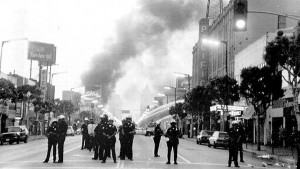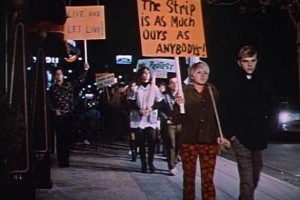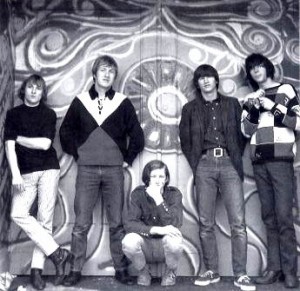-
-
-
![Michael Rosen]()
-
CIO Insights are written by Angeles' CIO Michael Rosen
Michael has more than 35 years experience as an institutional portfolio manager, investment strategist, trader and academic.
RSS: CIO Blog | All Media
For What It's Worth
Published: 08-21-2017
In the summer of 1966, throngs of young people crowded the Sunset Strip in Los Angeles to hear their favorite bands. Over at the Sunset Tower, Jim Morrison and the Doors were the house band, finishing up their first album (The Doors, with Light My Fire, and Break On Through, among other classics). Not to be outdone, a former policeman from Chicago, Elmer Valentine, opened the Whisky-A-Go-Go, featuring dancers in mini-skirts suspended in the air in a cage, thus inventing the Go-Go dancers. The Whisky also had a house band working on their debut album.
The year before, 1965, the Watts Riots engulfed Los Angeles in chaos. That next summer of 1966 saw tensions boiling over again in another part of the city. The clubs along Sunset Boulevard were proving so popular that residents complained about the crowds and the noise (and the drugs and the long-haired hippies). Mayor Sam Yorty imposed a strict 10 pm curfew, and had the police enforce it aggressively. On November 12, a protest against the curfew was organized, publicized on KROQ, which ensured a huge crowd. It quickly turned ugly: police wielding batons stormed into the crowd of over 1,000, cracking heads and carting people away, some in wagons, some in ambulances. Celebrities were also caught in the melee (this is LA, after all), with Peter Fonda among those handcuffed and jailed (his friend Jack Nicholson managed to escape).

There’s somethin’ happenin’ here.
What it is ain’t exactly clear.
Shocked by the violence in front of his club, the 21-year old guitarist for the Whisky’s house band sat down to write a song. The Watts Riots a year before, the Sunset Strip Riot now: something was definitely happening in Los Angeles, and in the country. Something disturbing; maybe something historic.Watts exposed the deepening racial rift in the city (and in the country). The inciting incident may have been the arrest of Marquette Frye under suspicion of drunk driving, but the context was much broader. For instance, like many states, California law restricted where certain people could rent or own property. In 1963, the state legislature passed the Rumford Fair Housing Act, prohibiting such discrimination. The following year, the California Real Estate Association sponsored Proposition 14 to overturn the Rumford Act. It passed overwhelmingly with 65% of the votes in the state, and a majority in every county. Racial restrictions in housing was again the law. The arrest of Marquette Frye sparked the riots, but Proposition 14 was a precipitous cause, emblematic of decades of racial discrimination and abuse.
The Sunset Strip Riot a year later highlighted the growing generational gap in the country. Los Angeles was where these two fissures, racial and generational, came together to tear the country apart. It became increasingly difficult for concerned citizens to find common ground as the sides held divergent perspectives and even appeared to speak different languages. Most Americans wanted no involvement in the debate, preferring to pursue their contented lives in the apparent tranquility and prosperity of post-war America. But all Americans would soon lose the luxury of indifference: the protests demanded that they choose sides.
There’s battle lines bein’ drawn.
Nobody’s right if everybody’s wrong.
We know with hindsight that the riots in Watts in 1965 and on the Sunset Strip in 1966 did not mark the apex of the protest movements. They did not precipitate the healing in American society, but the opposite, the beginning of the open rupture of the country, as many more, and more violent, protests were to come: Newark, Detroit, Kent State, among others.
Why? Why did the Los Angeles riots lead to “battle lines bein’ drawn”? To the further entrenchment of views, to greater polarization? Could anything have been done to bridge the differences, to unite the country, without a coming decade of death and violence unimaginable at the time?Paranoia strikes deep.
Into your life it will creep.
It starts when you’re always afraid.
The tragedy at Charlottesville last week resurrects in our collective memory these events of fifty years ago, and raises the same questions: does Charlottesville mark the beginning of an irreparable rift in our society? Will our views become further entrenched, further polarized, are we able to see the world only through one lens? Will we mend our society only after many more lives are sacrificed?
Charlottesville was a tragedy; can we turn it into an opportunity, an opportunity we missed in 1965? Racial discrimination is still pervasive, economic inequality is as prevalent as at any time in our history, and deaths from despair (suicide, drug overdose) are of epidemic proportions (https://angeles-srv.s3.amazonaws.com/content./1494344358./angeles-advisors-commentary-1qv217.pdf). Will we seek to understand the experiences of those suffering and commit our resources to help? Or are we too afraid, too paranoid, to acknowledge another point of view?We have another obligation, before it’s too late for constructive action: we must denounce as illegitimate those who espouse, excuse or condone bigotry. Free speech does not allow “falsely shouting fire in a theater,” as Justice Oliver Wendell Holmes, Jr. wrote (Schnenck v. United States, 1919); neither should it cover inciting violence and hatred. Protests over legitimate grievances seeking legal redress are welcomed, encouraged. Neo-Nazis are not. Those who see a moral equivalence are misguided and bigoted themselves. They must be condemned.
Reach out and speak up. There’s something important going down.
Opening with haunting harmonic notes on his guitar, For What It’s Worth became an instant classic, and secured the legendary genius of its composer, Stephen Stills. He did not think his song would become an icon of the protest movement, but it did. He was just trying to make sense of the riots on the Sunset Strip as artists do, through their art, pointing out the injustices in society, and demanding that we pay attention and respond. We are so obliged.
(I think it’s time we)
Stop, children, what’s that sound?
Everybody look — what’s going down?
(https://www.youtube.com/watch?v=gp5JCrSXkJY)
Print this Article
Related Articles
-
![Drop (in the bucket)]() 15 Sep, 2015
15 Sep, 2015Drop (in the bucket)
Markets will fluctuate, as Pierpont Morgan caustically observed. And "fluctuate" means down as well as up. Perhaps I, ...
-
![MLPs]() 15 Oct, 2014
15 Oct, 2014MLPs
Some historical data from Credit Suisse below: MLPs are off 14% this month, pretty bad. Subsequent performance (no ...
-
![Satisfaction]() 7 Aug, 2023
7 Aug, 2023Satisfaction
Why does the Fed insist that low unemployment drives higher inflation? Policymakers' imagination is being fired by ...
-




